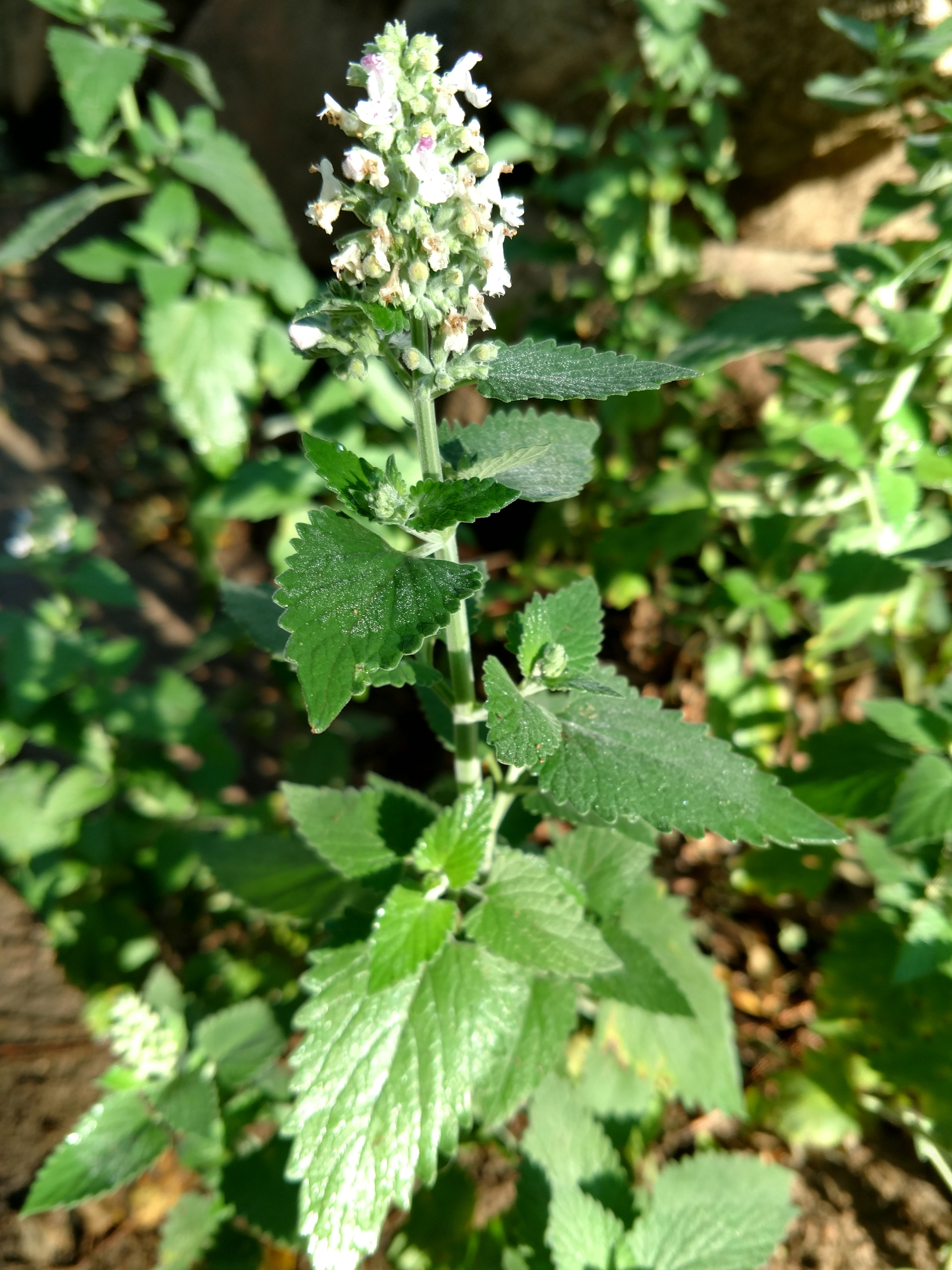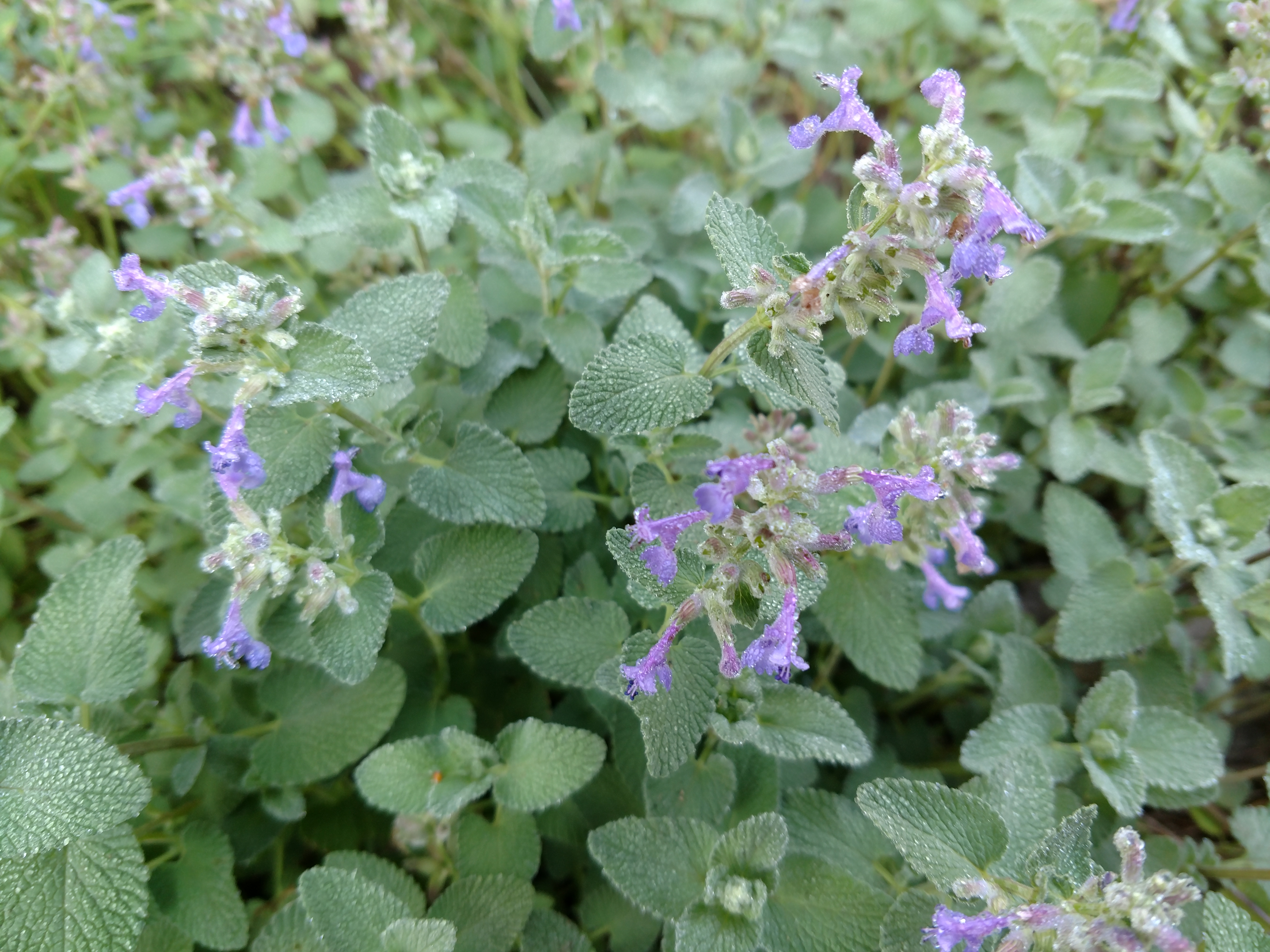 Catnip and Catmint - September 20, 2017 Jeff Schalau, Agent, Agriculture & Natural Resources University of Arizona Cooperative Extension, Yavapai County Catnip (Nepeta cataria) is native to Europe and a close relative of the mints (spearmint, peppermint, pennyroyal, etc). Many cats are attracted to the plant or dried herb and the smell can trigger strange behavior patterns. Some of these behaviors include licking, chewing, head shaking, chin and cheek rubbing, rolling, and salivation. Only about two-thirds of domestic cats respond to the herb. Lions, leopards, jaguars, and other cat species are also affected. Catnip is sometimes used as a folk remedy for fevers, colds, cramps, and migraines. Aside from pleasing cats and healing humans, catnip also has insecticidal properties. The active chemical in catnip is nepetalactone (a component of essential oil extracted from catnip). In the early 2000ís, Iowa State University researchers patented nepatalactone as a repellent for cockroaches, mosquitoes, mites, ticks, spiders, termites, and other insects. Since then, it has not been incorporated into commercially available insect repellents. Catnip oil also shows promise for use in crop protection. In a study, catnip intercropped with collard greens (planted in alternating rows) reduced the number of flea beetles: an insect very damaging to collards. Extracts of catnip have also been shown to eggplant from adult and larval stages of Colorado potato beetle and attract beneficial insects. Catnip extracts are not effective against caterpillars or moths and butterflies. Catnip is relatively easy to grow, tolerates a wide variety of soils, and probably has potential to invade your garden and beyond if not kept in check. Seed is available from many seed companies. The seed is very small and can be directly sown on well prepared garden soil and covered with 1/8" of soil. Alternatively, it can be sown in a flat and transplanted after it gets 5 sets of leaves. If you have cats, you may need to protect it from them until it becomes mature and established. Once established, each individual plant should survive for several years. Established plants can also be divided by cutting the root mass in half and replanting. The plants can get fairly large (3 feet tall), so grow them where they have adequate space. To harvest catnip, cut stems prior to flowering (early to mid summer). Remove leaves from the stems. Place the leaves on a screen or tray in a well-ventilated area out of direct sunlight. Turn the leaves once a day to provide aeration. After two or three weeks, it should be dry enough to crumble into flakes. Put dried flakes into a sealed jar or sealable plastic bag for storage. If you are a cat lover, a few catnip plants will provide a year round supply. Catmint (Nepeta x faassenii) is similar to catnip, but does not stimulate cats. It is a low-growing mounded plant with attractive, gray-green foliage. Itís profuse blue flowers appear in early summer and again through the monsoon season. It is heat and drought tolerant once established. It self-seeds and can spread (almost to the point of becoming weedy). These sturdy perennials are hardy to USDA zone 4, and will thrive in mountain gardens. Deer and most other herbivores are not attracted to catmint. Most gardeners consider it a good perennial border plant. Both catnip and catmint attract bees and other beneficial insects. Catnip usually only blooms once each season, but when it does, it attracts bees and other nectar feeders. Given catmintís extended bloom period, I see solitary bees feeding on nectar in early summer, honeybees using it in mid- to late summer, and bee flies and hawk moths using it in late summer. I grow both catnip and catmint. The catnip is harvested for use by cats. The catmint provides beauty and food for beneficial insects all summer long. See the below for photos and links to additional information. Follow the Backyard Gardener on Twitter Ė use the link on the BYG website. If you have other gardening questions, call the Master Gardener help line in the Camp Verde office at 928-554-8992 or e-mail us at verdevalleymg@gmail.com and be sure to include your name, address and phone number. Find past Backyard Gardener columns or provide feedback at the Backyard Gardener web site: http://cals.arizona.edu/yavapai/anr/hort/byg/. Photos  Catnip (Nepeta cataria) in flower (Jeff Schalau, 2017).
Catnip (Nepeta cataria) in flower (Jeff Schalau, 2017). Catmint (Nepeta x faassenii) in flower (Jeff Schalau, 2017).
Catmint (Nepeta x faassenii) in flower (Jeff Schalau, 2017).Additional Resources Catnip University of Illinois Extension extension.illinois.edu/herbs/catnip.cfm Catmint Colorado State University Extension planttalk.colostate.edu/topics/annuals-perennials/1053-catmint-nepeta/ |